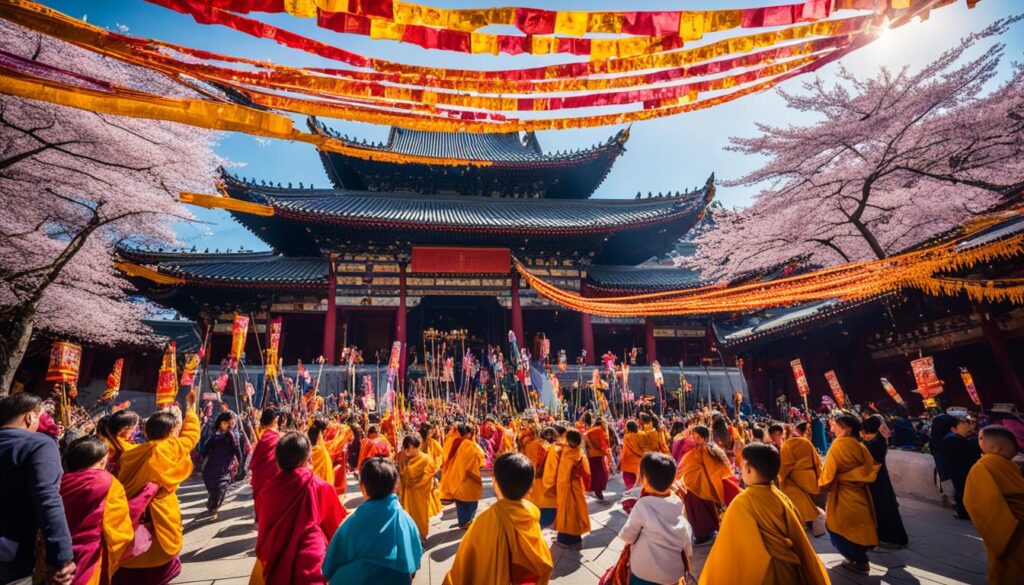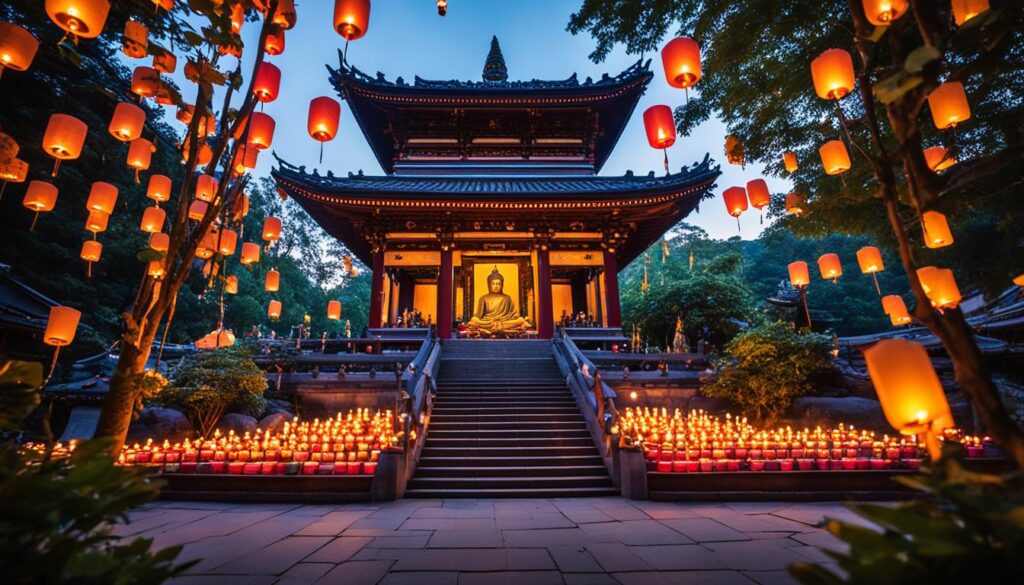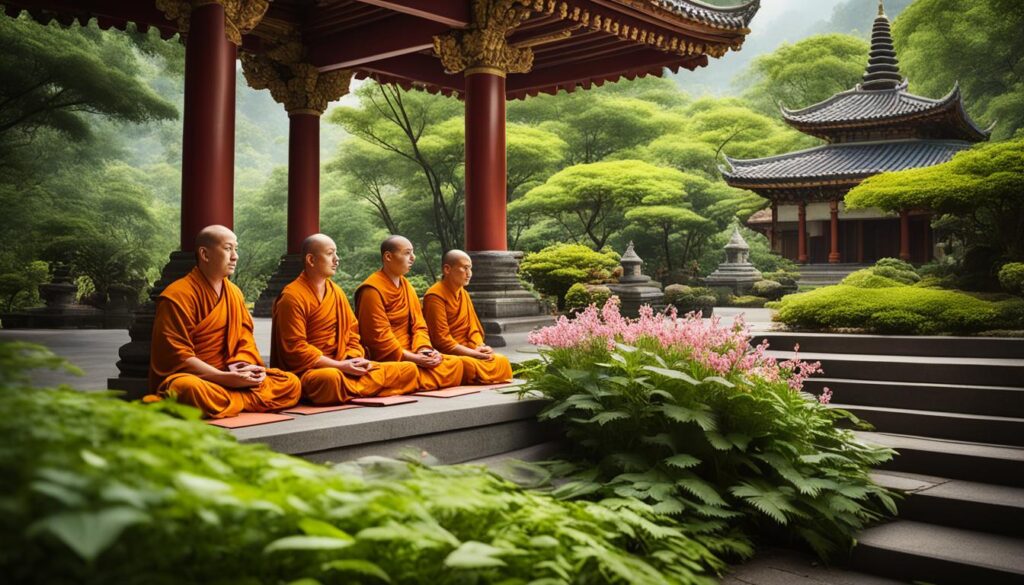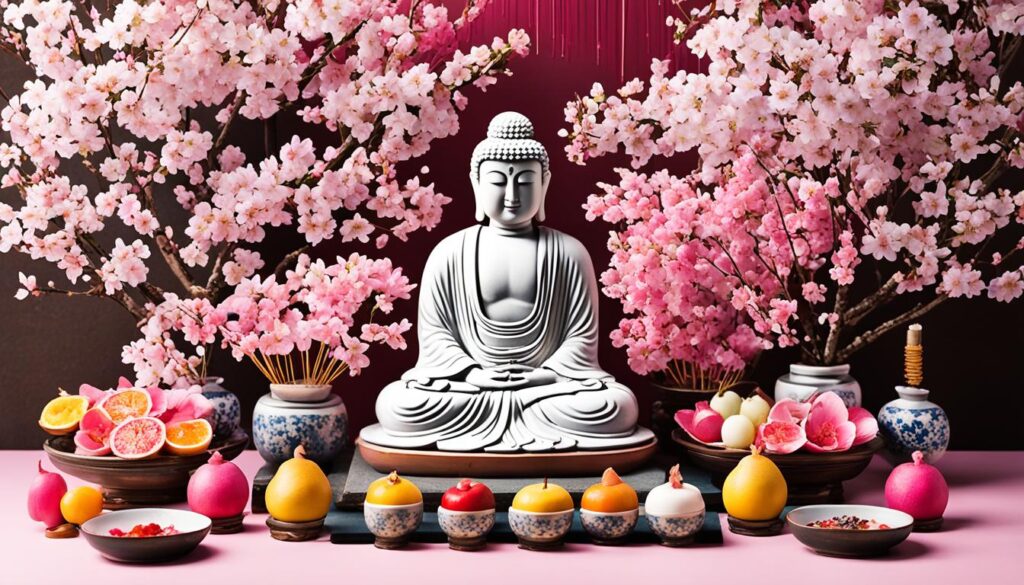Have you ever wondered how celebrating Buddhist holidays can provide a pathway to inner peace? Are you curious about the role of these traditional observances in addressing modern challenges? In this article, we will take you on a journey through the significance of Buddhist holidays and the various celebrations that take place throughout the year. Get ready to explore the depths of mindfulness, compassion, and wisdom embedded in these important events of the Buddhist calendar.
Key Takeaways:
- Discover how Buddhist holidays can deepen your understanding of mindfulness and compassion
- Explore the cultural significance of Buddhist festivals around the world
- Learn about the Buddhist New Year celebrations and their unique traditions
- Uncover the spiritual significance of Wesak, the celebration of Buddha’s life
- Delve into Vassa, a period dedicated to meditation and study
Buddhist New Year Celebrations
The Buddhist New Year is an auspicious occasion celebrated in various Buddhist cultures, signifying a time for renewal and purification. Customary practices for this significant event can differ across regions, but they all share the common goal of embracing fresh beginnings and spiritual rejuvenation. It is a time when homes are meticulously cleaned and offerings are made at monasteries or sacred sites as a symbol of devotion and gratitude. Let’s explore some of the most well-known Buddhist New Year celebrations that take place around the world.
Tibetan New Year: Losar
One of the vibrant and colorful Buddhist New Year celebrations is the Tibetan New Year, known as Losar. Losar is a grand affair that combines religious rituals, lively folk dances, traditional music, and gift-giving. During Losar, Tibetans pay homage to their ancestors and seek blessings for a prosperous year ahead. Losar celebrations often include elaborate ceremonies at monasteries, where monks perform sacred rituals to ward off evil spirits. This joyous occasion is marked with singing, dancing, feasting, and the lighting of butter lamps to bring light and positivity into the new year.
Japanese New Year: Shogatsu
In Japan, the Buddhist New Year, known as Shogatsu, carries a unique significance. Unlike other Buddhist New Year observances, Shogatsu aligns with the Gregorian calendar and begins on January 1st. It is a time when families come together to welcome the new year and reflect on the past. Many Japanese families visit temples on New Year’s Day to pray for good fortune and happiness. The ringing of bells at temples symbolizes the casting away of bad luck and the welcoming of fresh beginnings. Shogatsu is also marked by the tradition of sending New Year’s cards and enjoying special dishes that represent luck and prosperity.
Thai New Year: Songkran
Songkran is the traditional Thai New Year celebration, filled with joy, excitement, and vibrant water-throwing festivals. Held annually in mid-April, Songkran marks the beginning of the Thai lunar calendar and is a time for spiritual cleansing and renewal. The highlight of the festivities is the playful water fights, where people splash water on one another to wash away the past year’s misfortunes and bring luck for the upcoming year. Songkran is also a time for rituals of washing Buddha statues, visiting temples for offerings, and engaging in acts of charity.

| Country | Celebration | Date |
|---|---|---|
| Tibet | Losar | February/March (lunar calendar) |
| Japan | Shogatsu | January 1st |
| Thailand | Songkran | April 13th-15th |
These remarkable Buddhist New Year celebrations offer us a glimpse into the diversity of traditions and customs within Buddhist cultures. Each celebration holds deep cultural and religious significance, uniting communities in the spirit of hope, positivity, and new beginnings. Whether it is the colorful rituals of Losar, the temple visits and bell-ringing of Shogatsu, or the joyous water-throwing festivals of Songkran, Buddhist New Year celebrations carry a profound message of unity, renewal, and the power of collective celebration.
Wesak: Celebration of Buddha’s Life
Wesak is a significant Buddhist holiday that commemorates the birth, enlightenment, and death of the Buddha. For Theravada Buddhists, it is a time to decorate statues of the Buddha and take offerings to monasteries. This celebration often includes fireworks and is a time for reflection, meditation, and studying the teachings of Buddhism. Wesak is a time to honor the life and teachings of the Buddha and to deepen one’s spiritual practice.

During Wesak, devotees come together to celebrate the life and teachings of the Buddha. They engage in various rituals and practices that highlight the significance of this auspicious occasion. Wesak is particularly important for Theravada Buddhists, who follow the teachings of the Buddha as recorded in the Pali Canon.
The Birth of Buddha
Wesak marks the celebration of the birth of Siddhartha Gautama, who later became known as the Buddha. According to Buddhist tradition, Siddhartha Gautama was born into the royal family of Kapilavastu, located in present-day Nepal.
| Birth of Gautama Buddha | |
|---|---|
| Date | 563 BCE |
| Location | Kapilavastu, Nepal |
| Significance | Beginning of the life of the Buddha |
On Wesak, devotees commemorate Buddha’s birth by visiting temples, attending religious ceremonies, and participating in acts of generosity and kindness. They may also decorate statues of the Buddha with flowers and offer food and donations to monks and nuns.
The Enlightenment of Buddha
In addition to celebrating the birth of the Buddha, Wesak also commemorates his enlightenment. After renouncing his life of luxury, Siddhartha Gautama dedicated himself to a spiritual quest for truth. After years of meditation and self-discipline, he attained enlightenment under the Bodhi Tree in Bodh Gaya, India.
| Enlightenment of Gautama Buddha | |
|---|---|
| Date | 528 BCE |
| Location | Bodh Gaya, India |
| Significance | Attainment of enlightenment by the Buddha |
During Wesak, Buddhists reflect on the momentous event of Buddha’s enlightenment and strive to cultivate wisdom and insight in their own spiritual journeys. They engage in meditation, study sacred texts, and seek guidance from spiritual teachers to deepen their understanding of the path to enlightenment.
The Death of Buddha
Wesak also serves as a time to remember the passing of the Buddha, known as Parinirvana. According to Buddhist tradition, the Buddha attained Parinirvana in Kushinagar, India, at the age of 80.
| Death of Gautama Buddha | |
|---|---|
| Date | 483 BCE |
| Location | Kushinagar, India |
| Significance | Passing away of the Buddha |
On Wesak, Buddhists reflect on the impermanence of life and the teachings of the Buddha that guide them towards liberation from suffering. They engage in practices that promote compassion, mindfulness, and selflessness, paying tribute to the immense wisdom and compassion embodied by the Buddha.
Wesak is not only a time of celebration but also a period of deep reflection and spiritual nourishment for Theravada Buddhists. Through rituals, meditation, and acts of generosity, devotees strengthen their connection to the Buddha’s teachings and strive to live their lives in accordance with the principles of compassion, wisdom, and inner peace.
Vassa: Time for Meditation and Study
During Vassa, also known as the rainy season retreat, Buddhists immerse themselves in a period dedicated to meditation and study. This annual retreat originated from the tradition of monastics staying in one place during the rainy season, creating a conducive environment to deepen their understanding of the teachings and cultivate inner peace.
Vassa provides a unique opportunity for individuals to embark on a retreat, stepping away from the distractions of the world and focusing on inner reflection and spiritual growth. It is a time of self-discovery and contemplation amidst the tranquility of the rainy season, allowing practitioners to connect with themselves and the core teachings of Buddhism.
During this retreat, Buddhists set aside dedicated time for daily meditation, engaging in mindfulness practices to quiet the mind and cultivate a sense of serenity. Through sustained periods of meditation, individuals can develop a deeper understanding of themselves, their emotions, and their spiritual path.
Moreover, Vassa is also a time for intensive study. Buddhists delve into the sacred scriptures, studying the teachings of the Buddha and the commentaries provided by great Buddhist scholars throughout history. This deep engagement with the scriptures allows practitioners to gain profound insights into the nature of existence and the path towards liberation.
At the end of Vassa, Buddhists often bring new robes as offerings to the monks, symbolizing their commitment to the practice and their gratitude towards the monastic community. This act of generosity serves as a reminder of the interdependence between lay practitioners and monastics and fosters a sense of unity within the Buddhist community.
Overall, Vassa provides a conducive environment for practitioners to engage in intensive meditation and study, enabling them to deepen their understanding of the teachings and nurture their spiritual growth. This period of retreat offers a profound opportunity to cultivate mindfulness and wisdom, leading to a renewed sense of peace and purpose in one’s spiritual journey.

Other Buddhist Festivals
In addition to the Buddhist New Year and Wesak, there are other festivals celebrated in various Buddhist countries. These festivals reflect the diversity of Buddhist traditions and their rich cultural heritage. Let’s explore two fascinating festivals: Hana Matsuri and the Festival of the Sacred Tooth.
Hana Matsuri: The Flower Festival in Japan
Hana Matsuri, also known as the Flower Festival, is a joyous celebration in Japan that honors Buddha’s birthday. This festival takes place on April 8th and is marked by the beautiful tradition of decorating temples with vibrant cherry blossoms. Buddhists gather to pour scented tea over statues of the baby Buddha to signify the bathing of the newborn Buddha. It is a time of reverence, reflection, and appreciating the beauty of nature.
The Festival of the Sacred Tooth in India
In India, Buddhists celebrate the Festival of the Sacred Tooth, which commemorates Buddha’s first teaching after attaining enlightenment. This significant festival is held in the ancient city of Kandy, where the sacred tooth relic of the Buddha is enshrined. The highlight of the celebration is the grand parade of the sacred tooth through the streets, accompanied by vibrant processions, traditional music, and cultural performances. It is a time of deep devotion, spiritual reflection, and paying homage to the wisdom and teachings of the Buddha.

These festivals provide a glimpse into the cultural tapestry of Buddhist traditions, showcasing the harmonious blend of spiritual devotion, artistic expressions, and communal gatherings. Through these celebrations, Buddhists come together to honor the life and teachings of the Buddha, fostering a sense of unity, peace, and enlightenment.
Vesak: Celebrating Buddha’s Life and Enlightenment
Vesak is a significant holiday in the Buddhist calendar that commemorates the birth of Buddha, his enlightenment, and his reaching of Nirvana. It is a time of profound reflection and celebration of the life and teachings of the Buddha. Vesak is usually celebrated in May, during a full moon, which is believed to be the time of these important events in Buddha’s life.
During Vesak, Buddhist communities around the world come together to pay homage to the Buddha and his teachings. The celebration of Vesak varies across different countries with significant Buddhist populations, such as Sri Lanka, Cambodia, Thailand, and Myanmar, but the essence remains the same – honoring the life and enlightenment of the Buddha.
Temples are adorned with vibrant flags and flowers, creating a joyful and festive atmosphere. Devotees make offerings of flowers, incense, and candles to prominent statues of the Buddha, symbolizing their gratitude and reverence. The act of offering reflects the practice of letting go of attachments and cultivating generosity.
Celebrations often involve hymns, chants, and meditative practices that deepen the spiritual connection with the Buddha’s teachings. Processions may also take place, where devotees join together in a procession around the temple, carrying candles or lanterns symbolizing the light of wisdom that the Buddha illuminated.
Acts of kindness towards others are also an integral part of Vesak celebrations. Buddhists embrace the opportunity to engage in charitable activities and help those in need, embodying the principles of compassion and selflessness taught by the Buddha.
Vesak Celebrations Around the World
Vesak is celebrated in many countries where Buddhism is practiced. Each country adds its unique cultural elements to the festivities, making Vesak a vibrant and diverse celebration.
| Country | Celebration Highlights |
|---|---|
| Sri Lanka | In Sri Lanka, Vesak is celebrated as a week-long festival. The capital city of Colombo becomes the center of activity, with streets adorned with illuminated decorations and intricate lanterns. Devotees engage in religious observances and meditative practices throughout the week. |
| Cambodia | Cambodia celebrates Vesak with great enthusiasm. The country’s iconic temples, such as Angkor Wat, are beautifully illuminated, creating a breathtaking sight. Buddhists gather to offer prayers, meditate, and participate in ceremonies that evoke a sense of deep spirituality. |
| Thailand | In Thailand, Vesak is observed with dedication and reverence. The streets come alive with colorful processions, where people carry candles, incense, and flowers while chanting Buddhist scriptures. Thai Buddhists also engage in acts of merit, such as releasing captive animals as a compassionate gesture. |
| Myanmar | Vesak is a time of immense joy and devotion in Myanmar. Pagodas are adorned with countless colorful lights, and devotees flock to the sacred sites to offer donations and listen to sermons. The observance of Vesak in Myanmar is a profound spiritual experience that strengthens the bonds within Buddhist communities. |
Vesak is a special time for Buddhists to reflect on the Buddha’s teachings, cultivate mindfulness, and strive towards inner peace. It serves as a powerful reminder of the transformative potential within each individual and the ability to bring happiness and harmony to the world.
Vesak Celebrations Around the World
Vesak, also known as Buddha Purnima or Buddha Jayanti, is a joyous celebration that takes place in several countries where Buddhism is practiced. This auspicious occasion commemorates the birth, enlightenment, and death of Lord Buddha, the founder of Buddhism.
One of the prominent countries where Vesak festivities are observed is Sri Lanka. The island nation celebrates Vesak over a week-long period, with the capital city of Colombo being the center of activity. The city streets are adorned with vibrant decorations, and intricately designed lanterns illuminate the night sky. Devotees visit temples to offer prayers, perform acts of generosity, and engage in religious rituals.
In Indonesia, the ancient Buddhist temple of Borobudur becomes the focal point of Vesak celebrations. Borobudur is the world’s oldest Buddhist temple and is recognized as a UNESCO World Heritage site. Buddhists from around the globe flock to this majestic temple to participate in meditation sessions and witness the awe-inspiring release of lampions into the sky. This ritual symbolizes the liberation of one’s inner light and the dispelling of darkness.
Lumbini, located in present-day Nepal, is of great significance as it is believed to be the birthplace of Siddhartha Gautama, who later became known as Gautama Buddha. Vesak celebrations in Lumbini attract pilgrims from far and wide, who come to pay homage to the Buddha. The day of Vesak is widely celebrated in Nepal as Buddha Jayanti, a national holiday where people engage in prayers, meditation, and acts of compassion.
During these Vesak festivities, Buddhists come together to reflect on the life and teachings of the Buddha, embracing his message of compassion, mindfulness, and inner peace. It is a time for devotees to renew their commitment to the practice of Buddhism and strive towards cultivating virtues that bring them closer to enlightenment.
| Country | Key Celebration | Highlights |
|---|---|---|
| Sri Lanka | Colombo Vesak Festival | Week-long celebration with vibrant decorations, lanterns, and religious rituals |
| Indonesia | Borobudur Vesak Ceremony | Meditation sessions, releasing lampions into the sky |
| Nepal | Buddha Jayanti in Lumbini | Pilgrimage, prayers, and acts of compassion |
Conclusion
Buddhist holidays and festivals offer a profound opportunity for self-reflection and spiritual growth. By participating in these celebrations, you can deepen your understanding of mindfulness, compassion, and wisdom. Whether it’s the joyous festivities of the Buddhist New Year, the contemplative nature of Wesak, the dedicated period of meditation during Vassa, or the commemoration of the Buddha’s life and enlightenment in Vesak, each holiday serves as a reminder of the importance of inner peace and spreading kindness to others.
During these holidays, take the time to engage in reflection, meditation, and study the teachings of Buddhism. Use this opportunity to cultivate mindfulness, being fully present in the moment, and opening your heart to greater compassion for all beings. By embracing the essence of Buddhist holidays, you embark on a transformative spiritual journey that can bring harmony to your own life and contribute to a more compassionate and peaceful world.
Embracing the rich traditions of Buddhist holidays allows for personal and societal growth. The practice of mindfulness helps you to be fully present, living each moment with intention and awareness. Through cultivating compassion, you develop a deep empathy and kindness towards yourself and others. This inner peace and compassion become the foundation for creating a harmonious and caring society. So, embrace the wisdom and insights offered by Buddhist holidays, and may your journey be filled with mindfulness, compassion, and inner peace.
FAQ
What are Buddhist holidays?
Buddhist holidays are traditional observances that play a significant role in the spiritual journey of those who follow Buddhism. They provide opportunities for individuals to deepen their understanding of mindfulness, compassion, and wisdom.
Why are Buddhist holidays important?
Buddhist holidays are important because they offer a chance to address modern challenges and find inner peace amidst the complexities of life. They serve as reminders of the importance of self-reflection, meditation, and spreading kindness to others.
How is the Buddhist New Year celebrated?
The Buddhist New Year is celebrated differently in various Buddhist cultures. It often involves cleaning homes, making offerings at monasteries or sacred sites, and engaging in religious rituals. Examples of Buddhist New Year celebrations include Losar in Tibet, Shogatsu in Japan, and Songkran in Thailand.
What is Wesak?
Wesak is a significant Buddhist holiday that commemorates the birth, enlightenment, and death of the Buddha. It is a time for reflection, meditation, and studying the teachings of Buddhism. Celebrations often involve decorations, fireworks, and offerings at monasteries.
What is Vassa?
Vassa is a period during the Buddhist calendar dedicated to meditation and study. It originated from the time when it was challenging to travel and teach during the rainy season, so it became an opportune time for monastics to engage in retreats and deepen their understanding of the teachings.
What are some other Buddhist festivals?
Other Buddhist festivals include Hana Matsuri in Japan, which honors Buddha’s birthday and involves the decoration of temples with cherry blossoms, and the Festival of the Sacred Tooth in India, which commemorates Buddha’s first teaching and includes a parade of one of Buddha’s teeth through the streets.
What is Vesak?
Vesak is a significant holiday in the Buddhist calendar that commemorates the birth of Buddha, his enlightenment, and his reaching of Nirvana. It is usually celebrated in May, during a full moon, and varies across different countries with significant Buddhist populations.
How is Vesak celebrated around the world?
Vesak is celebrated in many countries where Buddhism is practiced, including Sri Lanka, Indonesia, and Nepal. Celebrations often involve adorning temples with flags and flowers, making offerings, and participating in hymns, chants, processions, and acts of kindness towards others.
What can I gain from celebrating Buddhist holidays?
By embracing Buddhist holidays, you can deepen your spiritual practice and cultivate qualities such as mindfulness, compassion, and wisdom. These celebrations provide a space for reflection, meditation, and studying the teachings of Buddhism, leading to personal and societal harmony.

